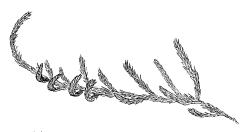The following family description uses elements from Crum & Anderson (1981).
Plants small, green or yellow-green, mat-forming. Stems creeping, much-branched, with scattered fascicles of rhizoids. Branches ascendant. Stem and branch leaves not differentiated, crowded, appressed when dry, spreading or rarely ± secund when moist, ovate to lanceolate and often acuminate, ± concave, usually not decurrent, unbordered, not or rarely weakly plicate; laminal cells rhombic, rhombic-hexagonal or rarely linear, smooth, thin- or firm-walled; alar cells quadrate or oblate, mostly forming large and opaque groups. Costa single, often weak, rarely absent. Paraphyllia mostly absent.
Mostly autoicous. Perichaetia and perigonia lateral, scattered on stem and branches, the perichaetial leaves rarely sheathing. Setae elongate, mostly pale; capsules erect and symmetric, with a short neck, wrinkled and often constricted below the transverse mouth when dry; exothecial cells thin-walled, often sinuose; stomata present in neck; annulus inconspicuous or absent, if present usually persistent; operculum umbonate or conic, sometimes rostrate. Peristome single and exostomal or rarely with a rudimentary endostome; exostome teeth often paired, lacking trabeculae; endostome absent in N.Z. taxa. Calyptra cucullate and naked.
The Fabroniaceae were treated by Brotherus (1925) as a family of 16 genera in four subfamilies, with species mostly distributed in tropical and subtropical regions. The family was reviewed by Buck & Crum (1978) who removed many of the genera with well-developed endostomes to the family Myriniaceae. The Fabroniaceae were further refined by Buck (1980, 1981). Goffinet et al. (2009) recognised only five genera in the Fabroniaceae, including the two occurring in N.Z., while maintaining separately the Myriniaceae. Their diagnoses of these two families contain few features that could distinguish them. Buck (1994) described the Fabroniaceae in greater detail in a treatment for Mexico and characterised it as consisting of "unusually small pleurocarps with non-hypnoid peristomes" while the Myriniaceae he considered to have fundamentally hypnoid but variably reduced peristomes. Buck (1998) further elaborated the differences between the two families in his treatment for the West Indies.
| 1 | Dioicous, not known to fruit in N.Z.; stem leaves >1.2 mm, entire or with a few weak teeth; upper laminal cells linear, mostly 60–75 μm; costa broad at base, obscured on adaxial surface by an extension of the alar group, mostly extending >½ the leaf length; lower margins reflexed on one or both sides; alar cell group ± concave | Ischyrodon |
| 1' | Autoicous, nearly always fruiting in N.Z.; stem leaves <l mm, irregularly spinose-toothed or occasionally entire; upper laminal cells rhombic-hexagonal, mostly 24–45 μm; costa faint even at base, not obscured on adaxial surface, mostly ⅓ –½ the leaf length; lower margins plane; alar cell group plane | Fabronia |
| Category | Number |
|---|---|
| Indigenous (Non-endemic) | 2 |
| Total | 2 |
Sainsbury (1955, p. 453) discussed in detail a plant collected by K.W. Allison at Queenstown on 25 Sep. 1947 (CHR 413841) that he [GOKS] considered to be "perhaps referable to this family". Buck (1981), in a paper largely devoted to the Fabroniaceae, described Bryobartlettia costata W.R.Buck, a new genus and species that he placed in the Leskeaceae. The holotype of B. costata is a specimen collected by J.K. Bartlett on 2 Jan. 1979 in the Cobb Valley (Nelson L.D.) and housed at NY; Buck cited the Allison Queenstown collection as a paratype. Beever (1992) examined the holotype of B. costata, a presumed isotype in the herbarium of J.K. Bartlett, and a paratype in CHR (413841), and redetermined all three as Cryphaea tenella. She noted that the presumed isotype and the paratype in CHR included both appressed stems (as described by Buck) and "typical stems of Cryphaea tenella bearing capsules".




